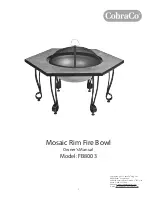
7. Check thermostat and replace if
defective.
8. Be sure 115 volts is supplied to the
transformer primary, then check for
24 volts at secondary terminal before
replacing.
9. Check and tighten all wiring connec-
tions per diagrams.
10. Replace, if necessary. Also see W, X
&
Y
symptoms.
1. Refer to “Installation, Venting”.
1. Relocate thermostat away from drafts.
2. Replace
thermostat.
3. Check wiring per diagrams.
4. Check operation at valve. Look for
short (such as staples piercing
thermostat wiring), and correct.
5. Replace gas valve.
6. Refer to “Operation”.
1. Tighten all electrical connections.
2. Adjust thermostat heat anticipator for
longer cycles. Refer to “Operation”.
3. Check for proper air supply across
heat
exchanger.
4. Relocate thermostat. (Do not mount
thermostat on unit).
5. Eliminate drafts. Refer to Installation.
6. Replace
ignitor.
7. Check for proper air supply across
heat
exchanger.
8. Jumper limit switch terminals 1 and 2.
If burner operates normally, replace
switch.
1. Replace or tighten.
2. Clean fan wheel.
3. Replace vibration isolators.
4. Oil bearings on fan motor. (Refer to
label on motor).
1. Open all manual gas valves.
2. Increase size of pilot
fl
ame. Refer to
“Operation”.
3. Purge air from gas supply.
4. Follow lighting instruction label
adjacent to gas valve.
5. Remove pilot ori
fi
ce. Clean with
compressed air or solvent. (Do not
ream).
6. Refer to “Operation”.
7. Check thermocouple connection,
and replace if defective.
8. Eliminate drafts. Refer to
“Installation”.
9. Inspect and correct all wiring.
10. Inspect and correct ignition system
wiring. See symptoms W, X, & Y.
11. Replace.
23
Power Vented Propellers Troubleshooting Guide
SYMPTOMS
POSSIBLE CAUSE(S)
CORRECTIVE ACTION
7. Defective
thermostat.
8. Defective
transformer.
9. Loose
wiring.
10. Defective ignition control.
1. Improper
venting.
1. Poor thermostat location.
2. Defective
thermostat.
3. Improper thermostat or transformer
wiring at gas valve.
4. Short
circuit.
5. Defective or sticking gas valve.
6. Excessive gas supply pressure.
1. Loose electrical connections at gas
valve or thermostat.
2. Excessive thermostat heat anticipator.
3. Unit cycling on high limit.
4. Poor thermostat location.
5. Draft on Pilot.
6. Defective ignitor control (if applicable).
7. Unit cycling on high limit.
8. Defective high limit switch.
1. Fan blades loose.
2. Fan blades dirty.
3. Vibration isolators deteriorated.
4. Bearings are dry.
1. Main gas off.
2. Pilot adjustment screw turned too low
on combination/automatic main gas
valve.
3. Air in gas line.
4. Incorrect lighting procedure.
5. Dirt in pilot ori
fi
ce.
6. Extremely high or low gas pressure.
7. Defective
thermocouple.
8. Drafts around unit.
9. Pilot valve not opening (faulty wiring).
10. No spark (faulty wiring).
11. Defective gas valve.
J. Condensation of water vapor.
K. Burner won't turn off.
L. Rapid burner cycling.
M. Noisy.
N. Pilot will not light or will not
stay
lit.
H. Failure to ignite.
Summary of Contents for QVSF 100
Page 10: ...10 Figure 6...
Page 11: ...11 Figure 7...
Page 12: ...12 Figure 8...
Page 13: ...13 FIGURE 9...






































